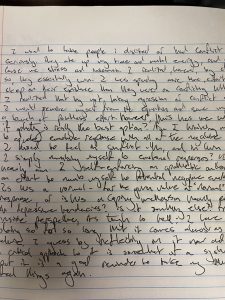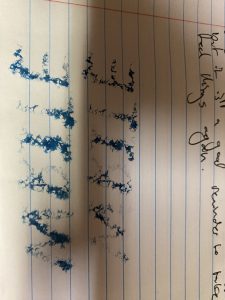
Writing this journal entry was a somewhat cathartic exercise, as I normally don’t write down my meditative thoughts when I am trying to self-reflect. Normally, I just let the thoughts bounce around in my head and try to acknowledge them individually before letting them go, so the practice of “pinning” it down on paper was oddly relaxing. I normally type rather than write by hand, for several reasons; I find it more deliberate to type, easier to edit, and somewhat obviously from the image above, easier to re-read! That being said, I do find it faster to write by hand; when I was doing my undergraduate degree, I wrote all of my lecture notes and class notes by hand, because it was easier to keep pace with the lecturer than to try and type at the same speed. I remember having a conversation with my literature professor several years ago about the speed at which I write, when I turned in my end of semester in-class final exam (3 hand written essays for which we had 2.5 hours to complete) in 35 minutes. I know I did well on the test, but he did comment on the “presentation” of my hand writing, which apparently has not gotten any better, looking back. As to editing and correcting mistakes, I tend to not do so with my hand-written work. If there is a misspelt word or an error in syntax, I tend to leave it as is, as I tend to write in a very stream-of-consciousness way. In this regard, my choice of medium absolutely plays a role in how I edit; when typing, I take the time to re-read, edit, and alter what I have written in order to ensure it is clear and concise, whereas when I write by hand all of that goes straight right out the window. I think both forms of written communication have their merits: speed aside, I think there is a level of genuine identity that comes across in hand-written works that can be overly sanitized in typed formats; mistakes, messy writing, and an overall different aesthetic feel have their place in the realm of written communication. Typing may be more efficient and cleaner, but it can strip away the “voice” one can find in hand-written works.

As for my attempt at using a self-generated “mechanized” (see- sponge with ink painted onto it) typing, there are several things that can be learned from my experience. Firstly, when using a stamping method, make sure you write everything backwards, otherwise you end up with ETIRW instead of WRITE. Secondly, use a sponge with a denser material, so the letters are legible instead of a blotchy mess. Lastly, use more ink, so the letters actually transfer onto the intended surface, instead of staring back at you at the end of your attempt with a slightly accusatory look on the sponge and not on the paper. With these lessons out of the way, I think I am ready to bring mass-produced print media to the world. Look out Johannes Gutenberg, I may be a few centuries behind you but boy am I coming for you quick now! In all seriousness though, the process was challenging, time-consuming, ill-suited for the task at hand, and in general just a pain. The onset of mechanized writing certainly has opened up the possibilities and accessibility to a much broader audience in regards to written communication and publication.